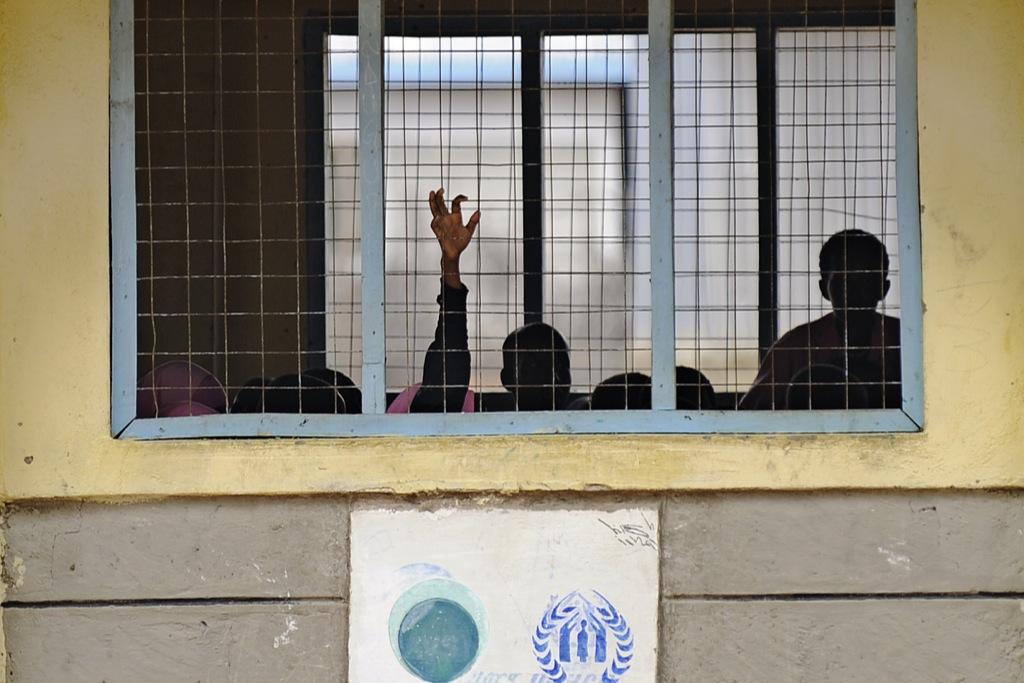Returning refugees from Kenya will destabilize Somalia
This April 12, 2013 photo shows students in a classroom at Undugu primary school, part of the sprawling Dadaab refugee complex in northeastern Kenya that’s home to more than 442,000 mainly Somali refugees.
NEW YORK — Somalia, Kenya, and the United Nations Refugee Agency (UNHCR) this week signed an agreement outlining the return to Somalia of nearly half a million refugees from Kenya.
Raising the specter of returns has reignited fear among Somali refugees and intensified a discussion in capitals across the Horn of Africa about the future of an additional half-million Somali refugees living in those countries.
Refugees and aid organizations are worried about so-called induced repatriation, whereby refugees will be pushed to return to Somalia prematurely.
Undeniably, there has been political and economic progress in Somalia, and stability has improved. The country has a new elected government, private investment is on the rise, and the military has made important gains, especially in bringing more security to Mogadishu.
However, the central government’s ability to translate these fragile gains into an inclusive political transition remains uncertain.
Security is still tenuous, particularly in the South-central region, where Al Shabaab maintains command of significant areas. A complicated web of local power holders controls other areas. Many in Somalia remain quite vulnerable to violence, and the vast majority of refugees and governments in the region and across the globe do not believe conditions exist now for the wide-scale, voluntary return of Somali refugees.
On a recent visit to Kenya, I met with refugees in a densely populated urban area in Nairobi and in the Dadaab refugee camp, the largest refugee camp in the world. Many told me they would like to return to Somalia one day, but only when it is peaceful and stable – conditions they do not yet see. Others believe they will never be able to return.
One young woman, who fled Somalia after losing both her parents in the civil war, told me she has no reason to return. Another spoke of friends who have returned to Somalia to find their homes occupied by others. Still others told me of relatives who have been met with violence, rape and sometimes death.
These stories underscore the need to contemplate a range of options for Somali refugees, from returning to Somalia to resettling elsewhere.
The international community should undoubtedly support refugees who decide to voluntarily return to Somalia. Some are already doing so and more will as conditions allow. But we must also support those refugees who do not believe they can return safely and in a dignified manner, now or possibly ever. Our conscience and international law require it.
Such flexibility in policy does not come without a cost. It requires financial support to ease the burden on countries willing to host refugees until conditions in Somalia improve.
Some countries in the region have been generously hosting Somalis for more than 20 years, and the new wave of Somali refugees after the 2011 famine has created additional burdens.
Although the number of refugees has continued to increase, budgets to support them are declining. The international community must reverse this trend. Otherwise, host countries may decide to roll up the welcome mat.
Part of the refugee funding should be invested in enhanced opportunities for education and skills development, which will benefit displaced refugees now and will also be critical tools for Somalia’s long-term success.
The training of health care providers and teachers among refugees, too, will help create a cadre of professionals who can meaningfully contribute to rebuilding Somalia when they do go home.
Ensuring protection and services for refugees now should not come at the cost of planning for the day when conditions will be more conducive for dignified, voluntary returns. To lay the foundation for such returns, the international community should take the following steps:
First, it must continue to support Somalia’s efforts to provide basic physical security for civilians. Unless refugees believe they will be protected from attacks and other forms of violence, they will not go home. The same is true for the more than 1 million Somalis who have been displaced internally by the ongoing conflict.
Second, to make any return feasible and sustainable, the government of Somalia — with the support of the international community — must strengthen basic services.
Third, investment in Somalia must be synchronized with humanitarian objectives. To this end, the UNHCR has identified three areas inside Somalia where voluntary returns of refugees in a phased approach may be possible.
To catalyze investments in these areas, donors should pursue better coordination between humanitarian needs and development dollars. The future of Somalia will depend on the degree to which the government and donor community prioritize the needs of the poorest and most vulnerable in long-term development efforts.
Such planning should not be used as a pretext for premature, unsustainable, and involuntary returns. Planning is prudent, but premature returns would increase the vulnerability of refugees and further destabilize Somalia.
This is an outcome the international community must vigorously seek to avoid.
Sharon Waxman is vice president of public policy and advocacy at the International Rescue Committee. She recently returned from a trip to Kenya.
We want to hear your feedback so we can keep improving our website, theworld.org. Please fill out this quick survey and let us know your thoughts (your answers will be anonymous). Thanks for your time!
